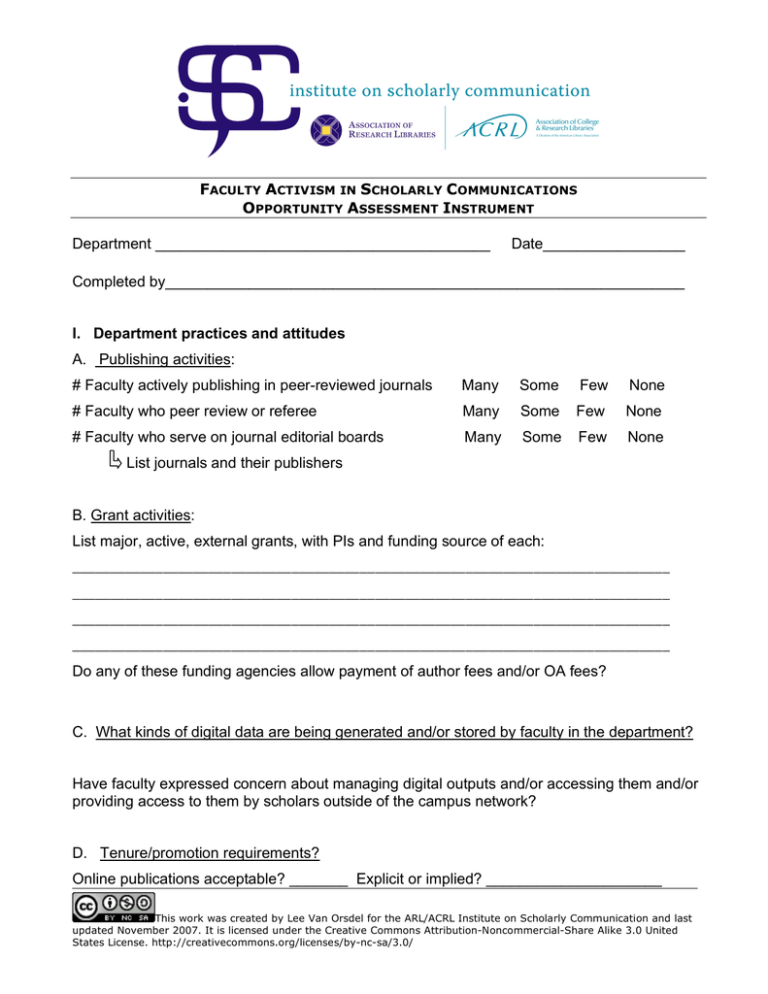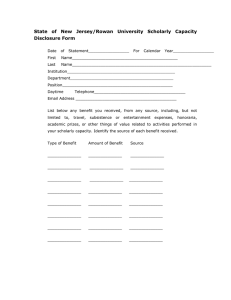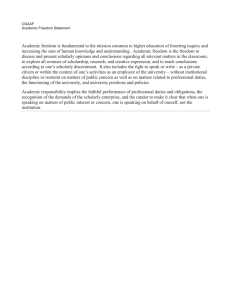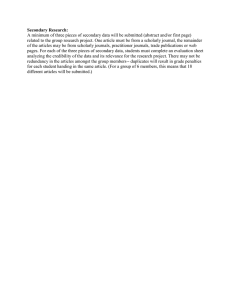Opportunity Assessment Instrument
advertisement

FACULTY ACTIVISM IN SCHOLARLY COMMUNICATIONS OPPORTUNITY ASSESSMENT INSTRUMENT Department ________________________________________ Date_________________ Completed by______________________________________________________________ I. Department practices and attitudes A. Publishing activities: # Faculty actively publishing in peer-reviewed journals Many Some Few None # Faculty who peer review or referee Many Some Few None # Faculty who serve on journal editorial boards Many Some Few None List journals and their publishers B. Grant activities: List major, active, external grants, with PIs and funding source of each: _______________________________________________________________________________ _______________________________________________________________________________ _______________________________________________________________________________ _______________________________________________________________________________ Do any of these funding agencies allow payment of author fees and/or OA fees? C. What kinds of digital data are being generated and/or stored by faculty in the department? Have faculty expressed concern about managing digital outputs and/or accessing them and/or providing access to them by scholars outside of the campus network? D. Tenure/promotion requirements? Online publications acceptable? _______ Explicit or implied? _____________________ This work was created by Lee Van Orsdel for the ARL/ACRL Institute on Scholarly Communication and last updated November 2007. It is licensed under the Creative Commons Attribution-Noncommercial-Share Alike 3.0 United States License. http://creativecommons.org/licenses/by-nc-sa/3.0/ ARL/ACRL Institute on Scholarly Communication Faculty Activism in Scholarly Communication – Opportunity Assessment Instrument 2 Are OA journals acceptable? _________ What are faculty perceptions of OA journals? Are citation/impact factors mentioned in departmental documentation? ______________ E. Any established activist behaviors? # Faculty who have published in an OA journal Many Some Few None # Faculty who have deposited journal article on web Many Some Few None # Faculty who are active promoters of OA Many Some Few None Who?___________________________________________________________ F. Any faculty who have already shown strong receptivity to Schol Comm issues and who might be inside advocate/partner/co-author? Who?___________________________________________________________ G. Any opposition, known or expected? II. Potential external Influences on Department A. Who do faculty in department see as their benchmarks at other institutions? Check websites: Are any of these benchmarks building strong programs around scholarly communications issues? Are faculty in department aware of these programs? B. Major professional society/ies associated with the discipline whose conferences and publications reach your faculty regularly: Name of Society Check website for evidence of Schol Comm awareness 1. Official statements on OA? _________________________ 2. Scholarly communications committee? ________________ 3. Recent conference programs on Schol Comm? _________ This work was created by Lee Van Orsdel for the ARL/ACRL Institute on Scholarly Communication and last updated November 2007. It is licensed under the Creative Commons Attribution-Noncommercial-Share Alike 3.0 United States License. http://creativecommons.org/licenses/by-nc-sa/3.0/ ARL/ACRL Institute on Scholarly Communication Faculty Activism in Scholarly Communication – Opportunity Assessment Instrument 3 4. Other evidence of awareness? ______________________ Does the society publish journal/s? What publisher, if any, do they contract with? Does the publisher offer OA or a hybrid option for authors? Are faculty aware of the option and its importance for OA? Does society make its backfiles OA after a certain period? C. Is there a disciplinary repository serving the field? Are faculty aware of the repository? Have any deposited articles there? D. Number of Open Access journals in discipline (listed in DOAJ)? Are faculty aware of these journals? III. Relationships with Librarians A. Assess overall strength of current relationship with Library? Who is library’s main contact within department? Any other strong connections between department and library to build on? Are there known liabilities/failures/difficulties with department? B. Have any presentations on Schol Comm been made to department recently? Successful encounter or not? Any noticeable outcomes? C. Potential entry points for librarians New faculty orientation? Yes No Maybe Contact: This work was created by Lee Van Orsdel for the ARL/ACRL Institute on Scholarly Communication and last updated November 2007. It is licensed under the Creative Commons Attribution-Noncommercial-Share Alike 3.0 United States License. http://creativecommons.org/licenses/by-nc-sa/3.0/ ARL/ACRL Institute on Scholarly Communication Faculty Activism in Scholarly Communication – Opportunity Assessment Instrument Committee on research/intellectual property? Yes 4 No Maybe Yes No Maybe Yes No Maybe Yes No Maybe Yes No Maybe Contact: Departmental publications? Contact: Colloquia/discussion groups? Contact: Graduate mentoring sessions? Contact: Junior faculty mentoring sessions? Contact: Other established communications with potential for input about Schol Comm? D. Specialists in department who might be natural allies? Intellectual property expert ___________________________________________ Grants officer _______________________________________________________ Director of graduate research __________________________________________ Sabbatical committee_________________________________________________ Others: First steps to take? What? Who? When? This work was created by Lee Van Orsdel for the ARL/ACRL Institute on Scholarly Communication and last updated November 2007. It is licensed under the Creative Commons Attribution-Noncommercial-Share Alike 3.0 United States License. http://creativecommons.org/licenses/by-nc-sa/3.0/ ARL/ACRL Institute on Scholarly Communication Faculty Activism in Scholarly Communication – Opportunity Assessment Instrument IV. What are they reading about scholarly publishing and OA? Identify the 10 or 12 core journals in the discipline—the ones most read by the faculty. Review recent issues for editorials or articles about OA, scholarly publishing, and related topics. Assess the nature and the bias of the messages they are likely receiving about these issues from their peers. This work was created by Lee Van Orsdel for the ARL/ACRL Institute on Scholarly Communication and last updated November 2007. It is licensed under the Creative Commons Attribution-Noncommercial-Share Alike 3.0 United States License. http://creativecommons.org/licenses/by-nc-sa/3.0/ 5



